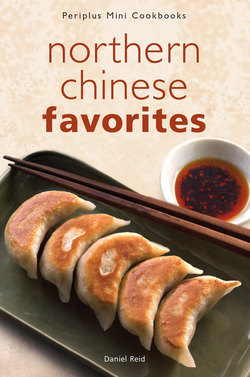Читать книгу Mini Northern Chinese Favorites - Reid - Страница 5
На сайте Литреса книга снята с продажи.
ОглавлениеBasic Northern Chinese Ingredients
Black Chinese mushrooms, also known as shiitake mushrooms, are used widely in Asian cooking. Dried ones must be soaked in hot water to soften before use, from 15 minutes to an hour depending on the thickness. The stems are removed and discarded; only the caps are used. Substitute porcini mushrooms. Fresh shiitake are widely available in most supermarkets now.
Black Chinese vinegar is made from rice, wheat and millet or sorghum. The best black vinegars are aged and have a complex, smoky flavor similar to balsamic, which may be substituted. Chinese cooks add black vinegar sparingly to sauces, dips and when braising meats.
Bok choy is a highly nutritious variety of cabbage with long, crisp stalks and spinach-like leaves. It has a clean, slightly peppery flavor and is a wonderful addition to soups and stir-fries. It is available in most large supermarkets.
Bottled chili sauce is a commercial blend of chili, vinegar, garlic and salt. Usually used as a dipping sauce, it can also be used on noodles and barbecued meats. Store in the refrigerator after opening.
Chili oil is made from dried chilies or chili powder steeped in oil. Bottled chili oil is also available in Asian markets.
Chinese cabbage, also known as Napa cabbage, has white stems that end in tightly packed pale green leaves. It has a mild, delicate taste.
Coriander leaves (also known as cilantro or Chinese parsley) are used as a herb and a garnish in Chinese cooking. Look for it in the herb section of the supermarket.
Dried prawns are tiny, orange shrimp that have been dried in the sun. They come in various sizes. Available in Asian markets, they should be orangy-pink and plump; avoid any with a grayish appearance or an unpleasant smell. Dried prawns will keep for several months in a sealed container.
Garlic chives or gu cai, also known as Chinese chives, have thin flat leaves that resemble thin spring onions. They have a strong garlicky flavor and are added to noodle or stir-fried dishes during the final stages of cooking. If you cannot get them, use spring onions or regular chives.
Ginger strips are thin strips of fresh ginger. To make your own, peel and thinly slice the required slices of ginger, then finely slice them into very long thin strips. They are usually teamed with black Chinese vinegar and used as a dip for pot sticker dumplings.
Glass noodles, also known as cellophane or bean thread noodles (dong fen in Mandarin), are thin, clear strands made from mung bean starch. They are sold dried and must be soaked in warm water for 15 minutes to soften.
Preserved eggs, also known as century eggs, are made by preserving duck, chicken or quail eggs in a mixture of clay, ash, salt, lime and rice straw for several weeks to several months, depending on the method of processing. The yolk of the egg becomes pale to dark green while the egg white becomes brown and transparent. The yolk is creamy with a strong aroma and an almost cheese-like flavor. The egg white has a gelatinous texture.
Rice vinegar is made from glutinous rice and has a mild, sweet flavor. It is colorless and is one of the definitive ingredients used in sweet and sour sauce. Substitute Japanese rice vinegar or white wine vinegar.
Rice wine or sake adds a sweet, subtle flavor to dishes. It is widely available in the specialty food sections of supermarkets. Dry sherry makes a good substitute.
Soy sauce is brewed from soybeans and wheat fermented with salt. Regular or light soy sauce is very salty and is used as a table dip and cooking seasoning. Dark soy sauce is denser and less salty and adds a smoky flavor to dishes.
Tofu or beancurd comes in various forms. Soft tofu is silky and smooth but difficult to cook because it falls apart easily. Firm tofu holds its shape well when cut or cooked and has a stronger, slightly sour taste. Pressed tofu (often confusingly labeled as firm tofu) is a type of firm tofu that has had much of the moisture pressed out of it and is therefore much firmer in texture and excellent for stir-fries. Refrigerate fresh tofu submerged in water in a plastic container. Tofu skin is the dried skin that forms on top of boiling soy milk; it is dried and sold in sheets.
Sesame oil is extracted from sesame seeds that have been toasted, producing a dark, dense and highly aromatic oil that is used for marinades, sauces and soups, or as a table condiment. Its nutty, smoky flavor has become a hallmark of north Asian cuisine.
Sichuan peppercorns, also known as Chinese pepper or flower pepper (hua jiao), have a sharp pungency that tingles and slightly numbs the lips and tongue—an effect known in Chinese as ma la (numb hot). To obtain ground Sichuan pepper, simply dry-roast Sichuan peppercorns in a frying pan, then grind to a fine powder using a mortar or pepper mill.
Spring onions, also known as scallions or green onions, have slender stalks with dark green leaves and white bases. They are sliced and sprinkled generously on soups and used as a garnish in Chinese cooking.
Wonton skins are made from wheat dough and come in a variety of sizes and thicknesses. They are filled with meat or vegetables, then steamed, fried or used in soups. Fresh or frozen wonton skins are available in most supermarkets.
Wood ear fungus, also called wood ear mushrooms, have very little flavor and are added to dishes for their chewy texture and as a meat substitute. They are sold dried in plastic packets in Asian supermarkets and comes in small, crinkly sheets. Soak them in water before using. Wash well and discard any hard bits that remain after soaking.
